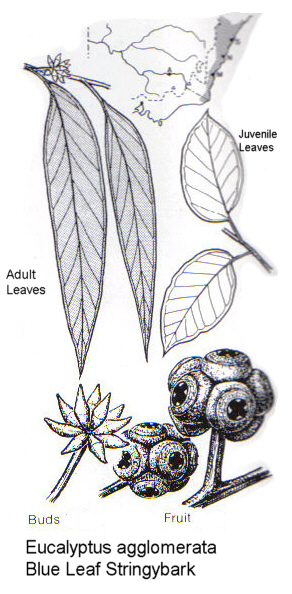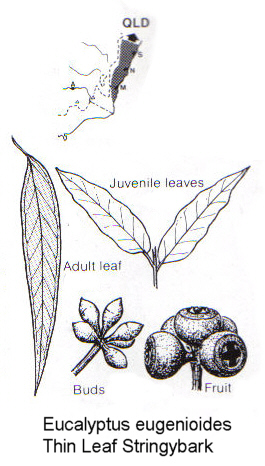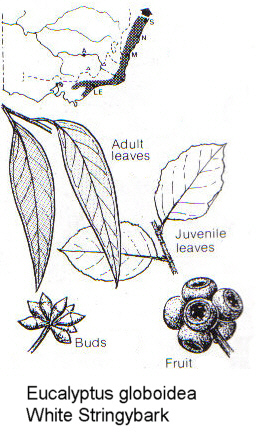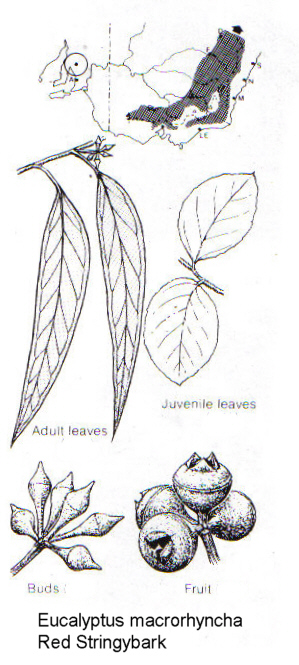



Wild Windellama
by Paul Alessi
March 2005
COMMON STRINGYBARKS Of WINDELLAMA
Most of us in Windellama that
have some natural bush or remnant
stands of timber will have Stringybark trees of some sort, all
are good firewood that
is usually straight grained and easy to split, most produce
pollen for excellent honey
and most are good for fencing and general building. There are
some trees
that resemble a stringybark and have much poorer timber so I
will include them in a future issue of Wild Windellama, there are
also another
two species of Stringybark I have found in Windellama but they
are rare here.
The following four are the most
common Stringybark species in Windellama,
What can make identification difficult is that
Stringybarks frequently hybridise so it can be very difficult to
make a positive
identification of some trees but mostly they fit into their usual
descriptions.
Eucalyptus globoidea (White
Stringybark)
Sometimes a very large spreading tree of good form with
smallish leaves, brighter green than Blue Leaf or Red Stringybark
with one side usually a different shade of green to the other.
prefers gullies and better soils, especially black soils in
sheltered sites,
rarely found on hilltops. The fruit capsules are about 5mm to 8
mm across,
rounded like a globe (hence the name E. globoidea) and usually
crowded together but
only just touching each other and not distorted.The wood is
usually pale in
colour and in older trees larger trees usually of excellent
milling quality.
Eucalyptus agglomerata ( Blue
Leaf Stringybark) Medium to large tree,
Likes hilltops above the frost line, rarely at the bottom of a
gully,
quite often in association with Eucalyptus sieberi (Silvertop Ash
) which
is sometimes refered to as Mountain Ash, true Mountain Ash
(Eucalyptus regnans)
which is the tallest hardwood tree species in the world does not
naturally occur in
New South Wales, Blue leaf Stringybark's leaves are larger than
White Stringybark
and if you stand back and look at the whole tree, depending on
the
direction of the sunlight the leaves they can take on a blue grey
look to them,
the fruit capsules are usually a slightly flattened globe,
tightly clustered and distorted where
they touch. The wood is again usually pale in colour, excellent
quality, strong and durable,
older trees are good for milling.
Eucalyptus eugenioides (Thin
leaf Stringybark) mostly medium sized and
more usually found north of Windellama Fire Shed towards Bungonia
and Marulan,
the leaves are thin as the name implies, longer than those of
White Stringybark and a
similar bright green but usually the same shade of green both
sides. The fruit capsules
are larger (to 10mm) only just touching or not touching at all.
The bark often shows
orange patches, often hard to tell from White Stringybark but the
timber qualities
are likely to be similar.
Eucalyptus macrorhyncha (Red
Stringybark) is small to medium sized and the most
common of our Stringybarks as it will grow almost anywhere
including poor sites,
it is often hollow inside and has a certain look to it that once
you are familiar with makes
identification easy, it rarely hybridises with the others and
since it's timber is less useful
for construction and not recommended for fencing it is good to be
able to pick this one
from the other stringybarks, it is the most widespread of the
species
and occurs across a large part of New South Wales and Victoria,
it is still good firewood,
flowers heavily and is nearly always easy to split. I've been
told that young trees are sometimes
very suitable for didgeridoos. The fruit capsules are large 8mm
to 12mm and in open clusters,
the fruit capsules also have 3 excerted (pointed) valves and turn
from green to red then dark
grey as they mature, often the fruit capsules are held on thin
pendulous branches that hang
vertically from the tree.The wood is usually pink to a reddish
brown colour.
I can be contacted on 02 48445149 or palessi@tpgi.com.au




Illustrations from Native Trees and Shrubs of South Eastern Australia by Leon Costermans
Copyright Paul Alessi 2005